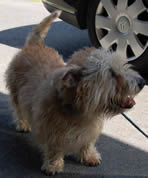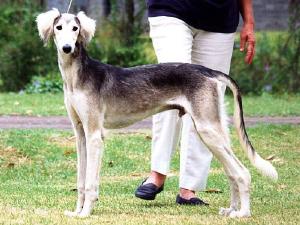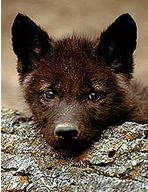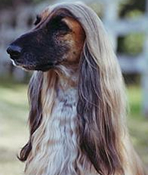
Dogs
The stunning, unique coloring of the Louisiana Catahoula leopard dog, or Cat, is the most outstanding characteristic of this breed. The Cat is known by many names, such as the Leopard Stock dog, the Black Mouth Cur, the Yellow Cur, the East Texas Cow or Hog dog, the Red Cur, the Old Brindle Cur, the Leopard Cur and the Louisiana Cur. The name frequently depends on the color of the dog.
The Cat is widely held to be descended from mastiff type war dogs bred with red wolves and Beaucerons (a French hunting dog); however, it is also reputed to have descended from Great Dane-type dogs. There are several histories existing for this breed. The most popular account is that Spanish settlers on the Gulf Coast brought with them Mastiff type war dogs. Native Americans in that area traded provisions for these dogs. Eventually the war dogs bred with the indigenous red wolf, producing a scent hound with webbed feet. French settlers soon discovered this wolf-like hunter and tried to create a superior hunting dog. The French bred the wolf-like dog with the Beauceron, producing Catahoula Leopard dogs.
Catahoulas were used to herd feral pigs and cattle that had escaped from the farmers' herds into the woods. Today, Cats are used to herd cattle, hogs, sheep and a number of other animals. They are particularly versatile hunters; their webbed feet tolerate many terrains.
Cats are named for a parish in Northeast Louisiana, the Catahoula parish. In 1979, the Catahoula Leopard dog was elected the state dog of Louisiana.
Catahoulas are not yet registered with the AKC, but are registered with many other associations.
The Catahoula's single coat is short; some can be coarse, and others are soft. They can be any color, or combination of colors, including solid, brindle and leopard. The most popular colors are merle, brindle and black and tan with mottled spots.
The Cat's body is powerfully built. The head is powerful and broad, giving them a commanding presence. A well-muscled body and webbed feet allow the Cat to acclimatize to just about any terrain. The deep chest permits the lungs to inflate, giving the Cat endurance and stamina.
Some Catahoulas are naturally bob-tailed; others have a medium length tail. The ears are medium in size, and pendulous.
Eye colors can be glass (blue), brown, green or amber. Cats frequently have eyes that are two different colors, and many have multiple colors on the same eye. The eye and coat colors of the Catahoula are similar to that of the Australian shepherd.
Catahoulas can weigh between 55 and 80 pounds. Females are between 20 and 24 inches tall at the shoulder, while males range from 22 to 26 inches tall.
Cats are reputed to have a very self-assured manner. They are frequently described as "assertive." They can be aggressive, and need to be socialized at an early age. They are exceptionally intelligent, and constantly try to establish alpha status, and it is imperative that the owner establish a no nonsense training attitude with these dogs, as they can be stubborn. Cats are extremely protective of their food; they should always be fed separate from other pets.
Catahoulas love attention. They are loyal companions, showing a great deal of affection to their family. They are very protective of their 'pack' and can be reserved with strangers; care should be taken when someone new comes into a Cats' territory. They are natural guardians and are always on alert for danger. They make wonderful guard dogs, but should never be ignored. Paying no attention to a Catahoula will create an unapproachable, aloof pet.
These are not city dogs. Apartment living is not recommended. Cats need plenty of hard exercise, at least one hour every day. A one-hour walk is not sufficient. Cats need to run, rain or shine. If not properly exercised, they tend to find other ways to burn off energy, typically in the form of destructive behavior. Keep this in mind when considering a Catahoula for your home.
Catahoulas are truly superior hunting dogs. They are brave and versatile, and make an outstanding dog for the right owner.
Catahoulas can be aggressive with strangers. This includes strange children. Daily interaction with the family is essential for socialization. They have dominant personalities, and can be aggressive with other animals. Care should be taken when introducing a Cat to your household, especially an adult.
Cats can be kept outside in most climates, but need a warm bed as they have a single coat. Cats need to stay inside in extremely cold temperatures.
These dogs are very intelligent, and highly trainable. Their dominant personalities require a firm hand and an abundance of patience. Ideally, a Cat should be trained at a very early age. They are good with obedience and agility, as long as the owner does not waver on discipline. Cats are particularly talented in Schutzhund training and in Search and Rescue training.
Catahoulas are not recommended for the average dog owner. They need acreage, or at least a large fenced in yard, as they require loads of hard exercise. A sturdy pen is required to house the Cat when company comes over.
In general, the Catahoula leopard dog is a healthy dog with few medical concerns. However, the following diseases or disorders have been reported:
Gastric torsion (bloat) is a life-threatening sudden illness associated with the stomach filling with air and twisting.
Hip dysplasia is a malformation of the hip joint that results in pain, lameness and arthritis.
Hypothyroidism results when the thyroid gland does not function adequately. Without enough thyroid hormone, illness can occur.
Diabetes is a disease of the pancreas related to insufficient amounts of insulin production.
In addition, the Catahoula leopard dog is also prone to deafness.
The average life expectancy of the Catahoula is 12 to 13 years.
We realize that each dog is unique and may display other characteristics. This profile provides generally accepted breed information only.
 Glen of Imaal Terriers: A guide to dogs and puppies of the Glen of Imaal Terrier breed
Glen of Imaal Terriers: A guide to dogs and puppies of the Glen of Imaal Terrier breed
 English Cocker Spaniels: A guide to dogs and puppies of the English Cocker Spaniel breed
English Cocker Spaniels: A guide to dogs and puppies of the English Cocker Spaniel breed
 Saluki
Saluki
 Schipperkes: A guide to dogs and puppies of the Schipperke breed
Schipperkes: A guide to dogs and puppies of the Schipperke breed
 Afghan Hounds: A guide to dogs and puppies of the Afghan Hound breed
Afghan Hounds: A guide to dogs and puppies of the Afghan Hound breed
 Miniature Pinschers: A guide to dogs and puppies of the Miniature Pinscher breed
Miniature Pinschers: A guide to dogs and puppies of the Miniature Pinscher breed
Copyright © 2005-2016 Pet Information All Rights Reserved
Contact us: www162date@outlook.com